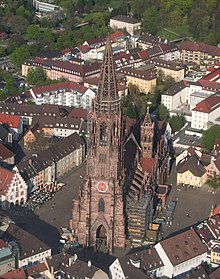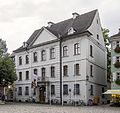Münsterplatz (Freiburg im Breisgau)
The Münsterplatz in Freiburg's old town is the paved area that surrounds the Freiburg Cathedral . The Freiburg Bächle flow along the edges of the square . The Münsterplatz is the largest square in the city.

description
On the south side of the Münsterplatz are u. a. the historic buildings "Haus zum Ritter" , the historic department store , Wentzingerhaus and Alte Wache, as well as the Kornhaus on the north side with the fish fountain .
Historic department store from 1532 with sculptures of Maximilian I , Philip the Handsome , Ferdinand I and Charles V.
Bay window with coat of arms of the imperial hereditary lands, surrounded by the golden fleece
Arched arcade at the historic department store
"Zum beautiful corner" in 1761 as a studio and residence of Joh. Chr. Wentzinger built
In front of the main portal of the minster under the minster tower, three pillars of patronage were erected in 1719, donated by the three united states of Upper Austria ( prelates , knighthood and Breisgauischer Städtebund) and decorated with their coats of arms. On the middle column stands the Virgin Mary as patroness of the cathedral; it is flanked by the two "younger" patrons of the city, Bishop Lambert von Liège (left) and the Roman martyr Alexander (right). The oldest Freiburg city patron St. Georg is missing here; he can be found - only a few meters away - as a golden knight on the Georgsbrunnen named after him from 1520/1935. Saint Lambert was venerated as the second city patron of Freiburg since the 14th century; The reason for this was his skull relic, which came to Freiburg in 1191 through one of his successors as Bishop of Liège, Rudolf von Zähringen , and has been highly venerated here ever since. The early Christian martyr Alexander is a catacomb saint whose relics were handed over by the Pope to an envoy from the city of Freiburg in 1650. St. In the 17th century, Alexander replaced St. George as the city patron of Freiburg on most of the depictions.
Maria as patroness of the minster on a sandstone column with decorative relief and Corinthian capital , on a pedestal with dedication inscription
Georgsbrunnen based on the old model by Carl Anton Meckel (1935)
The Fischbrunnen, a copy of the oldest and most magnificent fountain in the city, which was created in 1483 and originally at the intersection of "Große Gass" (today Kaiser-Joseph-Straße ) and Salzstraße, has stood in the northwest corner of Münsterplatz in front of the Kornhaus , so it was in the city center. It served as a market fountain and to sell fish. Although it was considered a symbol of urban market sovereignty, it had to give way to inner-city traffic in 1936. The fountain figures were made by Bertram von Berg in 1616. Grouped around the well are four statues on top of each other in canopies decorated with tracery . In the lower part there is Maria as patroness of the cathedral with the city patrons Georg and Lambert as well as an armored knight with the Austrian shield , probably Archduke Leopold III. von Habsburg (1351-1386), the then Upper Austrian sovereign. In the upper half are the four Latin Doctors of the Church Hieronymus (with the lion), Pope Gregory the Great (with tiara ), Ambrosius of Milan (with crosier and book) and Augustine of Hippo (with crosier and heart).
history
In the Middle Ages, the Freiburg market was located on the "Große Gass", today's Kaiser-Joseph-Straße. At that time, the cathedral was still surrounded by a churchyard , which served as the city cemetery on the north side. The approximately 1.60 meter high wall around the cathedral was not cleared until 1785. The St. Andreas cemetery chapel with an ossuary in the basement was demolished in 1752. Their ground plan is marked in the Rheinwacken pavement of today's square. The supply of the city with drinking water took place in the Middle Ages by running wells , u. a. on Münsterplatz, which are said to have been laid out shortly after the city was founded.
Floor plan of the former St. Andreas ossuary chapel on the north side of the minster
As early as 1514, in response to a letter from the Pope, Emperor Maximilian I ordered the cemetery to be relocated to the northern suburb of Neuburg for health and hygiene reasons . This cemetery at the parish church of St. Nikolaus, which was expanded several times, became unusable in 1677 in the course of the city fortifications by Vauban . In search of alternatives, the Freiburg residents resorted to the Münsterfriedhof to bury soldiers from the French garrison. Later, parts of the former Nikolaifriedhof could be used again as a civil cemetery. They form the basis of today's Old Cemetery . A market has been held on Münsterplatz at the latest since the final abandonment of the Münsterfriedhof.
When Freiburg was bombed on November 27, 1944 , almost all of the buildings on the edge of Münsterplatz were destroyed. Only the buildings on the southeast side with the historical department store, Wentzingerhaus and Alter Wache were largely spared, like the minster itself.
As a pilot project for a barrier-free city, a strip leading to the main portal of the minster was specially smoothed in 2012 in order to enable more comfortable access for people with wheelchairs and walking frames.
Münster market
Today the market takes place every weekday morning, which is unique in Germany. Only on August 15th, the feast of the Assumption of Mary , patronage of the cathedral, the square remains free of market stalls. On approximately 10,000 square meters, 80 to 180 (on Saturdays) market stalls offer food, handicrafts and souvenirs. The north side, the farmers' market, is reserved for local farms with mostly their own products. On certain occasions, such as the Freiburg Wine Festival, some market stalls have to move to the surrounding streets and sometimes to Kaiser-Joseph-Straße. Since the daily cleaning after the market with sweeping machines hollowed out the joints, these had to be filled up with new quartz sand from time to time. That is why the machine cleaning takes place only four times a year and the store suppliers have to take their rubbish with them. Until the creation of the Freiburg pedestrian zone in the 1970s, the square was used as a parking lot in the afternoons.
literature
- Lisa Renn: The Freiburg Cathedral Square - Archeology and History . In: Middle Ages on the Upper Rhine , November 25, 2015, http://oberrhein.hypotheses.org/1384
- Joachim Faller: On the history of the former churchyard wall around the Freiburg Minster. In: Freiburger Diözesan-Archiv 129 (2009), pp. 5–9, digitized
- Heiko Hartmann / Hans Schadek (ed.): History of the city of Freiburg im Breisgau , Theiss Verlag, Stuttgart 1996, vol. 1, p. 376ff.
Movie
- In the belly of Freiburg. The minster market. Documentary, Germany, 2015, 43:13 min., Script and direction: Stefano Tealdi and Ingo Behring, production: Stefilm, Ma.ja.de, ZDF , arte , RAI , RSI , HRT , series: Im Bauch von… , first broadcast : July 18, 2015 at arte, table of contents by arte, review .
Web links
Individual evidence
- ^ Square of the Old Synagogue - www.freiburg.de. Retrieved April 4, 2019 .
- ↑ Hans Georg Wehrens: The three patronage columns in front of the main portal of the Freiburg Minster . In: Münsterblatt des Freiburger Münsterbauverein , No. 23/2016, pages 5–18 with illustrations
- ^ Hans Georg Wehrens: The city patron of Freiburg im Breisgau . In: Journal of the Breisgau history association "Schau-ins-Land" . 126 (annual booklet). Promo Verlag Freiburg, 2007, p. 39–68 with addendum 130, 2011, pp. 67–69 . Preview of: Freiburg historical holdings - digital , Freiburg University Library (shortened text), accessed on February 10, 2016.
- ^ Hans Georg Wehrens: The city patron of Freiburg im Breisgau . Freiburg 2007, p. 19ff.
- ↑ Peter Kalchthaler, Guido Linke, Mirja Straub (eds.), Gotik construction site. The Freiburg Minster . Exhibition catalog, p. 147; Petersberg (Hessen) 2013, Michael Imhof Verlag
- ^ State bibliography of Baden-Württemberg. Retrieved August 14, 2013 .
- ^ Hans Georg Wehrens: Freiburg im Breisgau 1504 - 1803. Woodcuts and copper engravings . Freiburg 2004, p. 108ff.
- ^ Hans Georg Wehrens: Freiburg im Breisgau 1504 - 1803. Woodcuts and copper engravings . Freiburg 2004, p. 125ff.
- ↑ Klaus Humpert / Martin Schenk: Discovery of medieval urban planning, Stuttgart 2001, p. 94ff. and 370
- ↑ Friedrich Kempf: The old cemeteries . In: Baden Architects and Engineers Association, Upper Rhine District (Ed.): Freiburg im Breisgau. The city and its buildings . HM Poppen & Sohn, Freiburg im Breisgau 1898, p. 410 ( Scan - Wikisource ).
- ^ Frank Zimmermann: Barrier-free Freiburg? A concept is still missing. Badische Zeitung, September 6, 2012, accessed on November 6, 2018 .
- ^ Daniela Frahm: Freiburg: Passion for the cathedral market. Badische Zeitung, April 12, 2017, accessed on April 12, 2017 .
- ↑ Freiburg Cathedral Market. Freiburg Wirtschaft Touristik und Messe (FWTM), accessed on February 10, 2016 .
- ↑ Dieter Saier, master paver at the gardening and civil engineering department of the city of Freiburg, November 6, 2018
- ↑ Guidelines on the weekly market on Münsterplatz in the city of Freiburg i. Br..pdf. May 23, 2017, accessed November 6, 2018 .
Coordinates: 47 ° 59 '44 " N , 7 ° 51' 8.7" E























